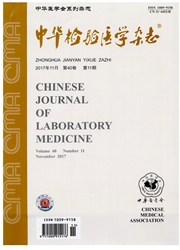

 中文摘要:
中文摘要:
目的探讨缺血性脑卒中(IS)各亚型患者外周血白细胞Homer表达水平变化及临床价值。方法回顾性研究。收集2015年7月至2016年6月期间中南医院266例患者全血(平均年龄:72.1±11.7;男172例,女94例),样本分为5组:大动脉粥样硬化型(LAA)100例,心源性脑栓塞型(CE)42例,小动脉闭塞型(SVO)68例,其他明确病因型(SOE)23例和不明原因型(SUE)33例,同时收集同期健康体检者126例(平均年龄:71.3±8.1;男84例,女42例)。其中IS诊断符合中国急性缺血性脑卒中诊治指南2010年标准。使用RT-qPCR法检测白细胞Homer含量(经对数转换后呈正态分布),采用Oneway ANOVA分析Homer在亚组中表达水平,采用ROC曲线分析计算曲线下面积(AUC)及其95%置信区间(CI),多项Logistic回归分析计算风险比(OR)值及其95% CI。结果LAA组Homer1(2.01±0.15)和Homer2(1.81±0.31)水平显著高于其他病例组(Homer1 CE:2.40±0.34;SVO:2.38±0.35;SOE:2.36±0.33;SUE:2.40±0.30;Homer2 CE:2.09±0.38;SVO:2.08±0.30;SOE:2.09±0.41;SUE:2.10±0.34)(Homer1 CE:t=9.353,P〈0.001;SVO:t=9.258,P〈0.001;SOE:t=5.396,P〈0.001;SUE:t=9.644,P〈0.001;Homer2 CE:t=4.725,P〈0.001;SVO:t=5.545,P〈0.001;SOE:t=3.640,P〈0.001;SUE:t=4.669,P〈0.001)和对照组(Homer1:2.35±0.28;Homer2:2.12±0.31)(Homer1:t=11.882,P〈0.001;Homer2:t=8.464,P〈0.001)。而非LAA病例组及健康对照组中Homer1(F=0.940,P=0.441)和Homer2(F=0.336,P=0.854)表达差异无统计学意义。各组间Homer3表达差异均无统计学意义(F=0.641,P=0.669)。Logistic回归分析显示,在校正了年龄、性别及血脂水平等的影响后,白细胞Homer1与Homer2水平的升高与LAA(Homer1:OR=8.62, 95% CI:4.13~18.00,P〈0.001;Homer2:OR=2.42,95% CI:1.75~3.36,P〈0.001)的发?
 英文摘要:
英文摘要:
ObjectiveTo investigate clinical significance of Homer expression in peripheral blood leukocytes of patients with ischemic stroke (IS).MethodsIt was a retrospecive study. The gene expression levels of Homer were measured by RT-qPCR. 266 patientscollected in Zhongnan Hospital from September 2015 to June 2016were divided into 5 groups: large-artery atherosclerosis (LAA, 100 cases), cardioembolism (CE, 42 cases), small vessel occlusion (SVO, 68 cases), stroke of other demonstrated etiology (SOE, 23 cases) and stroke of undemonstrated etiology (SUE, 33 cases). Meanwhile, age and sex matched 126 healthy controls were also collected. IS diagnostic criteria for cerebral infarctionwas in accordance with the guideline for acute ischemic stroke in China in 2010. The levels of Homers in subgroups were compared by Oneway ANOVA. The area under curve (AUC) and 95% confidence interval (CI) were calculated using ROC analyses. The odds ratio (OR) and 95% CI were calculated using the multivariate logistic regression analyses.ResultsThe levels of Homer1[2.01±0.15]and Homer2[1.81±0.31]in LAA patients were significantly higher than othergroups[Homer1 CE: 2.40±0.34; SVO: 2.38±0.35; SOE: 2.36±0.33; SUE: 2.40±0.30; control group: 2.35±0.28; Homer2 CE: 2.09±0.38; SVO: 2.08±0.30; SOE: 2.09±0.41; SUE: 2.10±0.34; control group: 2.12±0.31](Homer1 CE: t=9.353, P〈0.001; SVO: t=9.258, P〈0.001; SOE: t=5.396, P〈0.001; SUE: t=9.644, P〈0.001; control group: t=11.882, P〈0.001; Homer2 CE: t=4.725, P〈0.001; SVO: t=5.545, P〈0.001; SOE: t=3.640, P〈0.001; SUE: t=4.669, P〈0.001); There was no significant difference in the expression of Homer1 (F=0.940, P=0.441) and Homer2 (F=0.336, P=0.854) between non-LAA groupsand healthy controls. There was no significant difference in the expression of Homer3among the groups(F=0.641, P=0.669). Multinomial logistic regression analyses revealed that, higher Homer1 (adjusted OR=8.62, 95% CI: 4.13-
 同期刊论文项目
同期刊论文项目
 同项目期刊论文
同项目期刊论文
 期刊信息
期刊信息
